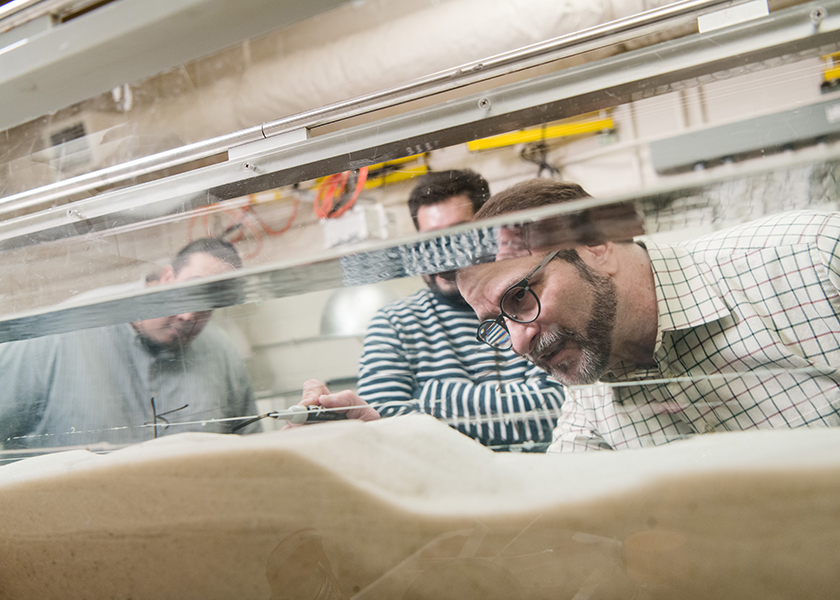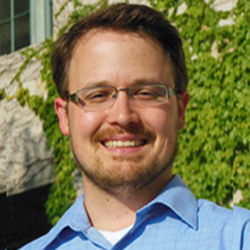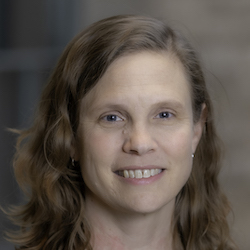In Israel, Forging a Path to a Circular Water Economy
Efforts in sustainable water management are a key focus of study abroad trip and scientific collaborations

Almost every day, new evidence of a global water crisis emerges.
The second-largest water reservoir in the United States, Lake Powell, seeped to its lowest level in nearly 60 years this past winter. The picturesque canals of Venice ran dry, while France went more than a month without significant rainfall.
Meanwhile, drought conditions around the world continue to threaten agriculture, wildlife, and public health.
The global water supply is at risk, and the crisis seems to be accelerating faster than solutions can be developed. And yet remedies are emerging — in particular, through the US-Israel Collaborative Water-Energy Research Center (CoWERC),a global collaboration co-founded by scientists at Northwestern’s Center for Water Research, and in Israel, a nation long at the forefront of water innovation.
After sounding the alarm on its shrinking freshwater supply more than a decade ago, Israel now desalinates about 75 percent of its drinking water from the Mediterranean Sea. It is also the global leader in reclaiming its wastewater, repurposing almost 90 percent for agricultural irrigation and other purposes.
These advancements are a key focus of Northwestern’s annual Global Engineering Trek to Israel (GET), an annual study-abroad trip co-organized by the University’s Israel Innovation Project and the Center for Water Research, and supported by McCormick Global Initiatives and the Institute for Sustainability and Energy at Northwestern (ISEN). The trek enables undergraduates to travel to Israel to learn about the latest advancements in sustainable water management.
“It was amazing to me that Israel was able to implement practical solutions [to its water crisis] so quickly,” said Peter Pinder, a junior majoring in civil engineering who traveled to Israel on the GET trip last fall. “Their ability to create change and turn this issue around so that they are now a global leader in this area is quite impressive.”
A complete view of the water-energy system
CoWERC was founded three years ago by Northwestern and Ben-Gurion University of the Negev in Israel.
“We have a wide range of expertise, so we have the ability to take a pretty broad view and then focus on the most impactful work,” said Aaron Packman, co-director of CoWERC and director of the Center for Water Research.

Water and energy are inextricably linked, said Packman, a professor of civil and environmental engineering at Northwestern Engineering. The purification and distribution of water require significant amounts of energy, while water, in turn, is essential to the production of energy. And wastewater itself contains a substantial amount of energy.
Innovations and efficiencies in any of those processes can have an exponential impact on the cycle, generating more water for human consumption and agriculture and more energy for a variety of other purposes.
Turning wastewater into energy
Wastewater may not be potable, but it does contain nutrients. It’s also full of energy that can be used for other purposes.

That’s why George Wells, associate professor of civil and environmental engineering, and his team are working to change the way we view wastewater — from mere “sewage” to something that can be used for energy, fertilization, and other purposes.
The Wells lab is developing a new technology called CANDO+P that can recover nutrients from wastewater while producing clean water for reuse. This process removes nitrogen in a manner that allows it to be used for bioenergy, while phosphorus is recovered in a form that can be reused as fertilizer.
Innovative approaches like CANDO+P have an enormous potential to lower the barriers to wastewater reuse, Wells explained.
“These new technologies ultimately provide a path toward a truly circular water economy,” he said. “That vision is vitally important not just to Israel and the US, but to sustainable water stewardship worldwide.”
More water for agriculture
Resources usually diminish as the population increases. But that’s not true for wastewater, which is perhaps the only “resource” that becomes more plentiful as the population grows. As a result, scientists are especially keen to find ways to improve the quality of wastewater so that more of it can be used for other purposes.
In Israel, Professor Alex Furman and his team at Technion-Israel Institute of Technology are testing a new method for cleaning wastewater destined for agricultural irrigation. By injecting the soil with air, the researchers have found that they can hasten the natural processes by which elements such as carbon and nitrogen are oxidized and effectively removed from the water.
These new technologies ultimately provide a path toward a truly circular water economy. That vision is vitally important not just to Israel and the US, but to sustainable water stewardship worldwide.
George WellsAssociate Professor of Civil and Environmental Engineering
According to Furman, this approach has the potential to vastly increase the amount of wastewater available for irrigation purposes and to ensure that water is even cleaner than when it left the treatment plant.
“This process could double the capacity of our facilities in the field,” he said.
Smarter investments in water filtration
Filtration membranes — physical barriers dotted with nano- or even smaller-sized pores — are essential to desalinating and decontaminating water. The membranes trap fine particles and ions, including pollutants and salt, and allow clean water to emerge on the other side.
But the membranes are costly to maintain. Contaminants accumulate on the surface, requiring more pressure and thus more energy to push the water through the pores. A more effective membrane that resists the accumulation of contaminants is available, but it is more expensive.

However, a recent study led by Jennifer Dunn, associate professor of chemical and biological engineering and director of Northwestern’s Center for Engineering Sustainability and Resilience, found that treatment facilities would save money over the long term by installing these more effective membranes. And this could free up more capital for new desalination plants and other sustainable technologies.
“Anything we can do to improve the membrane’s lifetime or reduce cleaning costs will help reduce the cost of clean water,” Dunn said.
Leveraging the Israel innovation strategy
These studies and others by Northwestern and Israeli researchers have the potential to impact the water-energy system in a fundamental way. Through funding and collaboration, CoWERC supports these efforts and assists in their progression from the lab to the field.
“We’re leveraging the Israel innovation strategy to scale up and test things that we can then deploy here,” Packman said.
And by tapping into the varied conditions and demands of US water infrastructure, researchers can quickly ascertain just how applicable solutions are to conditions around the world.
“We have some of the best groups in the world involved in this, and we have very clear strategies,” Packman said. “We have very good momentum in getting our work from the laboratory out into the field.”